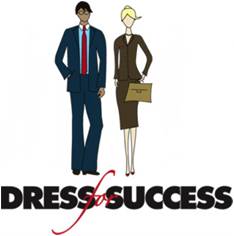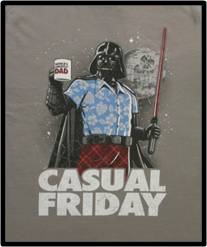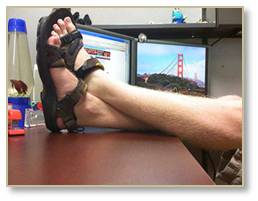Monday Author: Susanne Skinner
Dress codes have undergone a significant amount of change in most of our career lifetimes. When I entered the workforce the standard uniform for men was a suit, complete with power tie. Professional women were equally well dressed.
 Today, we accept that suites are no longer the norm, or at least not the suits from the 80s. Organizations have adopted a relaxed style of dressing called business casual that has evolved to polos and khakis for men and something similar for women. The power tie has been retired.
Today, we accept that suites are no longer the norm, or at least not the suits from the 80s. Organizations have adopted a relaxed style of dressing called business casual that has evolved to polos and khakis for men and something similar for women. The power tie has been retired.
I pursued a career in the high tech industry, a field dominated by men with a lot of suits.You put one on and went to work.I did too, every day, and I loved it.
Even though it was the 80s there was a visible difference in the dress code of the company I worked for. Their headquarters was housed in an old, un-renovated woolen mill and I worked side-by-side with engineers who wore jeans and college t-shirts. A few of them also followed a (self-imposed) no-bathing-required rule.
They were poster children for the new un-dress code that was coming.
Casual Friday
 In recent years there has been an easing of office dress code, even in some of the more formal professions like law and accounting. Casual Friday, which morphed into dressing casually during the entire week, was very prevalent during the Dot Com start-ups of the 1990s and early 2000s. Some companies were so blasé about it that shorts and sandals were common attire.
In recent years there has been an easing of office dress code, even in some of the more formal professions like law and accounting. Casual Friday, which morphed into dressing casually during the entire week, was very prevalent during the Dot Com start-ups of the 1990s and early 2000s. Some companies were so blasé about it that shorts and sandals were common attire.
Casual Friday was a day of non-conformity that ushered jeans into the workplace and ultimately led to more relaxed office attire. The high tech industry cannot take credit for it, although they embraced it and made it their own.
The concept had its roots in Hawaii, in 1962, when the state’s Fashion Guild began a campaign to make the Hawaiian shirt—also known as the Aloha shirt—a standard component of the state’s business attire.
Suits in a hot climate were impractical, and their efforts resulted in an edict from the Hawaiian government and Tom Selleck, recommending “the male populace return to ‘aloha attire’ during the summer months for the sake of comfort and in support of the 50th state’s garment industry.”
 On the mainland, a similar idea was pioneered at Hewlett-Packard in the 1950s. Friday was known as Blue Sky Day, inviting employees to relax in body, mind and attire and channel creativity into innovation. At the end of the day jeans clad employees joined the founders for beer and brainstorming.
On the mainland, a similar idea was pioneered at Hewlett-Packard in the 1950s. Friday was known as Blue Sky Day, inviting employees to relax in body, mind and attire and channel creativity into innovation. At the end of the day jeans clad employees joined the founders for beer and brainstorming.
The concept gained momentum in the 90s. Businesses were looking for a way to raise morale during a slumped economy that did not involve increasing salaries. They began experimenting with an interpretation of Aloha Friday to create a more casual environment on the last day of the work week. Employees loved the idea and actually looked forward to it.
Business Casual
By the mid 2000s the suit or corporate uniform was on its way out. The new CEO was a millionaire in his twenties wearing a tee-shirt and a hoodie, or black jeans and a turtleneck. Even the esteemed Mr. Blackwell said, “Like it or not, the corporate world had to loosen its dress codes to work with them.”
The office landscape also changed as workers began telecommuting. Not just working from home, but literally working in their PJs and slippers or by the pool. The lines between work and life blurred and the term work clothes became undefined and vague.
Emma McClendon, who curated an exhibit called Uniformity for the Museum at the Fashion Institute of Technology, summed it up: “We are in a very murky period.”
What Not to Wear
Corporations follow somewhat loose guidelines when it comes to office dress codes. Obvious no-nos should be clear, and since most non-factory workers conform to accepted standards of business attire there isn’t a whole lot of space devoted to it in employee handbooks.
 That is, until 2010, when UBS decided to create their now infamous dress code. It might have gone unnoticed except the Internet reveals all. The Swiss bank created a 44-page booklet of guidelines that included instructions on how often men should get their hair cut, clip their nails and acceptable shades of underwear for women. After the Internet Frenzy the guide was modified, however the bank retains a mandatory dress code for men of a dark suit, black shoes, white shirt and red tie.
That is, until 2010, when UBS decided to create their now infamous dress code. It might have gone unnoticed except the Internet reveals all. The Swiss bank created a 44-page booklet of guidelines that included instructions on how often men should get their hair cut, clip their nails and acceptable shades of underwear for women. After the Internet Frenzy the guide was modified, however the bank retains a mandatory dress code for men of a dark suit, black shoes, white shirt and red tie.
Today there is no difference between Friday and other days of the week when it comes to level of dress in the high tech industry. Power dressing is gone, and most styles reflect casual comfort and a relaxed image that makes it difficult to tell the CEO from the IT person.
This is not true for every company. Retail businesses, insurance and law firms and service organizations often have detailed dress codes or require uniforms and logos for easy employee identification.
The New Balance
Despite a relaxed dress code, attention to detail is still important. Clean, pressed clothing makes a positive impression, along with good grooming and no heavy smells of any kind. I have a thing for polished shoes and belts, no matter what style you embrace.
Dress codes are a balancing act. I prefer a company with a “dress appropriately” culture allowing managers to work with their teams to determine what this looks like. A workplace should maintain an air of professionalism as well as safety, and apply common sense across all departments.
Culture is defined from the top down, and the start-up environment is known for its free-form style. Larger, established organizations err on the side of conservative. There is no definitive study that says we are what we wear, but I feel productive when I am dressed appropriately in my office.
Those of us in the seasoned workforce understand business attire, while Millennials keep it open to interpretation. It’s a new day at the office.

Underwear is a must have item for many women for the obvious practical reasons. Lingerie, on the other hand, does not only have the power to add a spark to your sex life, but can also go a long way in boosting the confidence of the women wearing it. What matters most when it comes to lingerie and underwear is comfort and different factors determine how comfortable you remain when wearing your chosen garment. There are a few things that you should know about women’s underwear if at all you are to be able to buy the most suitable.Suitable fit of underwear can do wonders on a woman’s body. It can increase her self-confidence. It can elevate her normal body figure and it can put here in the best state. Sizes of body control underwear vary to suit the different forms of the women’s bodies but it must be exact to avoid form and support issues.
I don’t mind – and in fact appreciate – “business casual”. But it’s degenerated from there. I’ve seen engineering team leaders in outfits that look like they’re headed to the “meat market” bar right after work; I’ve seen women in sexy attire more suited to that same club environment. I’ve seen degreed engineers in scruffy, torn jeans and stained T-shirts.
https://davidhuntpe.wordpress.com/2013/08/20/fit-to-be-tied/
(Sorry, shameless but appropriate self-promotion.)